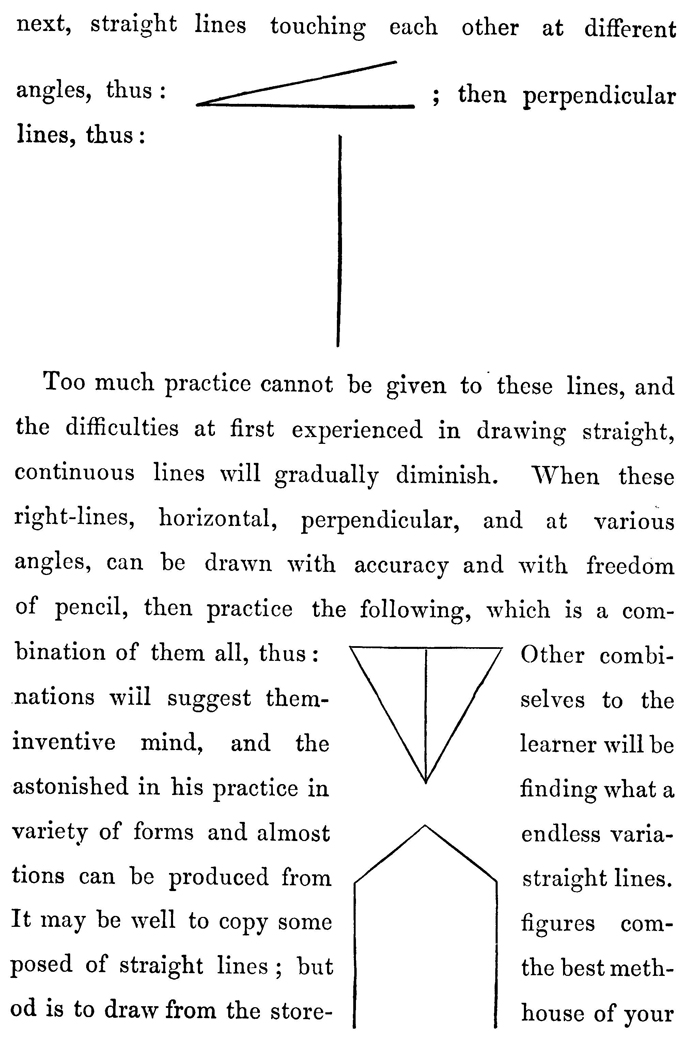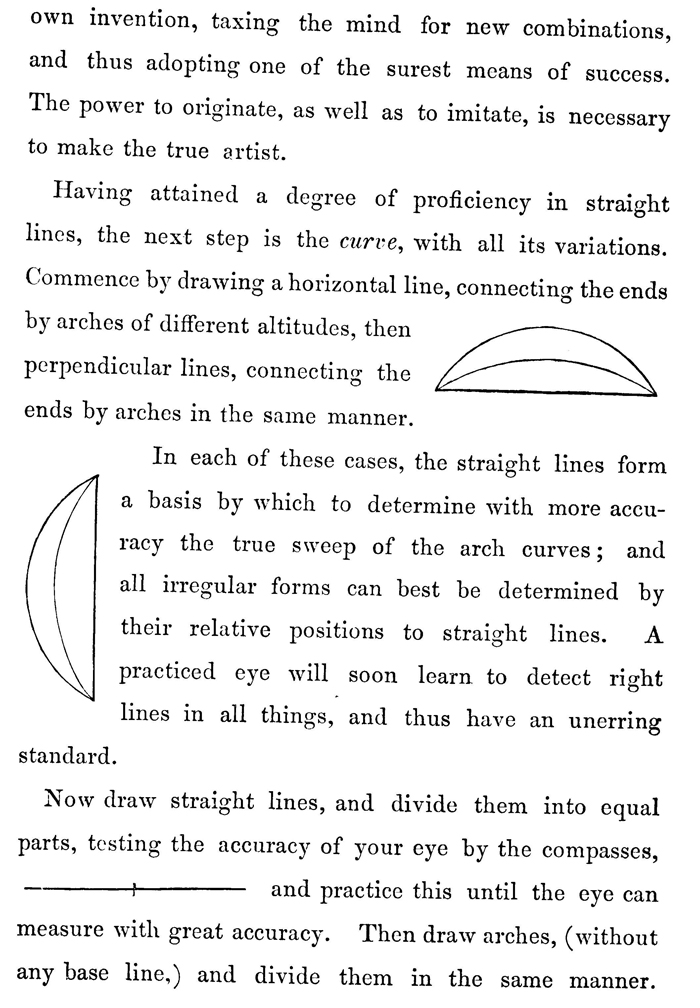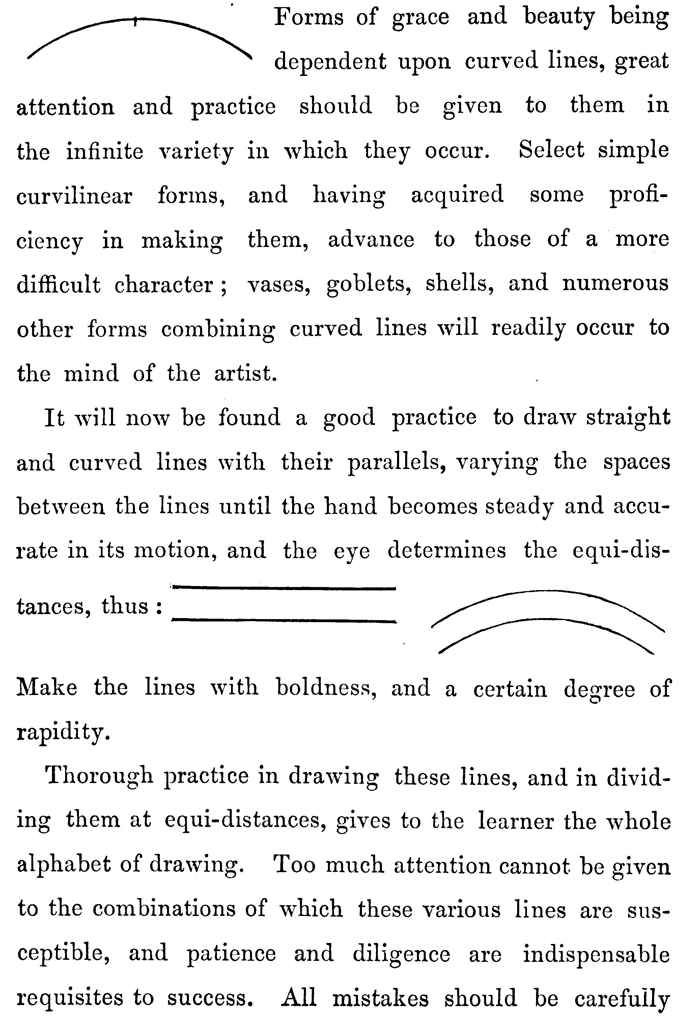Home > Directory of Drawing Lessons > How to Improve Your Drawings > Drawing Confident Lines > Draw More Confident Lines
How to Draw Confident Lines with Freehand Drawing Exercises and Practice Lessons & Tutorials
|
|
The text above is actually images, so if you need to copy some of the text, you can do it below. DRAWING CONFIDENT LINES
Art, by which we imitate the beauties of the exterior world, and transfer to or canvas the creations of our imagination, is not only a pleasing accomplishment, but of practical utility in every department of human life ; and while, as in every branch of study, all cannot expect to attain to equal excellence, there is no one who does not possess within him a germ which, with proper cultivation, will develop itself in some degree of artistic beauty. As in music, so in drawing, to become a master of the art requires a life-long labor and constant application ; and yet it is within the reach of all to acquire such a knowledge, and such an experience, as to produce pleasing effects, to cultivate and elevate our tastes for the beautiful in nature and art, and decorate our dwellings with representations of the outer world, and make permanent with the pencil the dreamy imaginations which float in the ever-active mind.
Drawing should become an essential element in our popular education, for while it conduces to our pleasure and amusement, practical advantages naturally flow from it; and although in an elementary treatise like this it is impossible to enter into the minute details necessary for high proficiency in the art, yet it is believed the attentive student will find here an incentive for further study, and that, by following the concise but systematic directions here given, he will, although a beginner, be enabled to produce pleasing pictures with a true artistic effect, and lay the foundation for a thorough knowledge of the principles of drawing. Success in any thing is in proportion to the exertion put forth by the art student.
A perfect muscular control of the hand is of the first importance in drawing, as accuracy of outline and delicacy of expression can only be obtained by having the fingers in complete subjection to the will, so that the slightest volition will be properly interpreted by the pencil. This requisite facility in the use of the pencil or brush can be acquired only by patient practice, the length of time necessary for its attainment being in some degree dependent upon the natural ability, taste, or " genius " of the learner. Of equal importance, and as absolutely indispensable, is correctness of eye in determining distances and measurements — an attainment which can be carried to a wonderful degree of perfection. Thorough practice in making straight and curved lines demands the first attention of the beginner. Commence with short horizontal lines, gradually increasing the length, making the line in a distinct, bold, and rapid manner, first from left to right, and then vice versa, thus : next, straight lines touching each other at different angles, thus : lines, thus : then perpendicular.
Too much practice cannot be given to these lines, and the difficulties at first experienced in drawing straight, continuous lines will gradually diminish. When these right-lines, horizontal, perpendicular, and at various angles, can be drawn with accuracy and with freedom of pencil, then practice the following, which is a combination of them all, thus : Other combinations will suggest themselves to the inventive mind, and the learner will be astonished in his practice in finding what a variety of forms and almost endless variations can be produced from straight lines.
It may be well to copy some figures composed of straight lines ; but the best method is to draw from the store house of your own invention, taxing the mind for new combinations, and thus adopting one of the surest means of success. The power to originate, as well as to imitate, is necessary to make the true artist. Having attained a degree of proficiency in straight lines, the next step is the curve, with all its variations. Commence by drawing a horizontal line, connecting the ends by arches of different altitudes, then perpendicular lines, connecting the ends by arches in the same manner.
In each of these cases, the straight lines form a basis by which to determine with more accuracy the true sweep of the arch curves ; and all irregular forms can best be determined by their relative positions to straight lines. A practiced eye will soon learn to detect right lines in all things, and thus have an unerring standard.
Now draw straight lines, and divide them into equal parts, testing the accuracy of your eye by the compasses, and practice this until the eye can measure with great accuracy. Then draw arches, (without any base line,) and divide them in the same manner.
Forms of grace and beauty being dependent upon curved lines, great attention and practice should be given to them in the infinite variety in which they occur. Select simple curvilinear forms, and having acquired some proficiency in making them, advance to those of a more difficult character ; vases, goblets, shells, and numerous other forms combining curved lines will readily occur to the mind of the artist.
It will now be found a good practice to draw straight and curved lines with their parallels, varying the spaces between the lines until the hand becomes steady and accurate in its motion, and the eye determines the equi-distances. Make the lines with boldness, and a certain degree of rapidity.
Thorough practice in drawing these lines, and in dividing them at equi-distances, gives to the learner the whole alphabet of drawing. Too much attention cannot be given to the combinations of which these various lines are susceptible, and patience and diligence are indispensable requisites to success. All mistakes should be carefully corrected, not in imagination, but in reality, as thus the hand and eye gain experience. Fruit and flowers are interesting models from which to draw, and these can be followed by more complicated subjects. |
Privacy Policy ...... Contact Us









